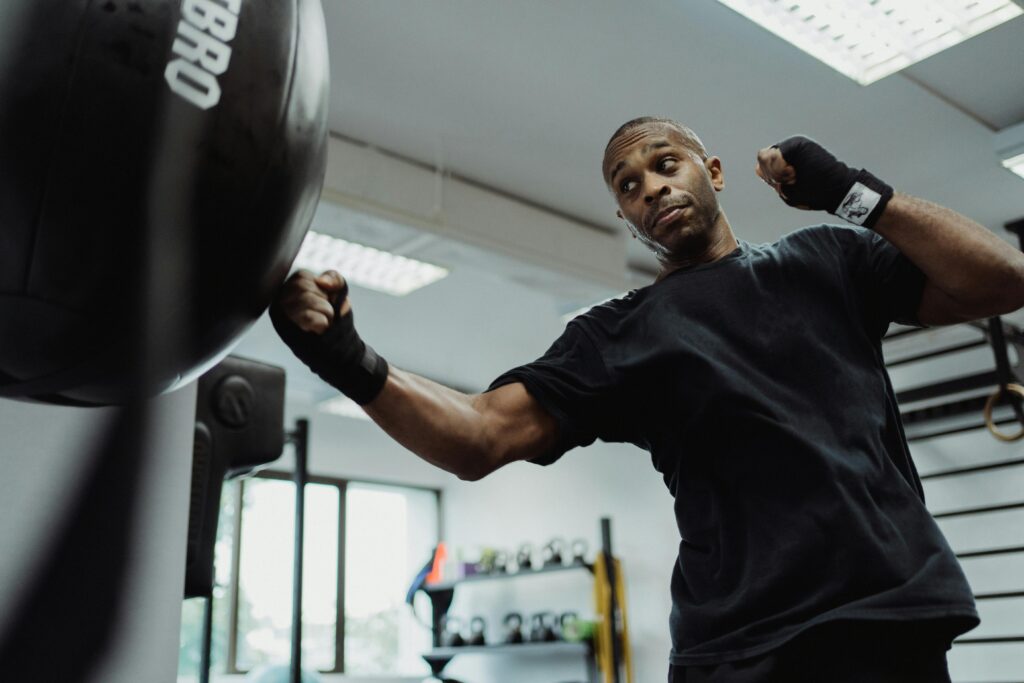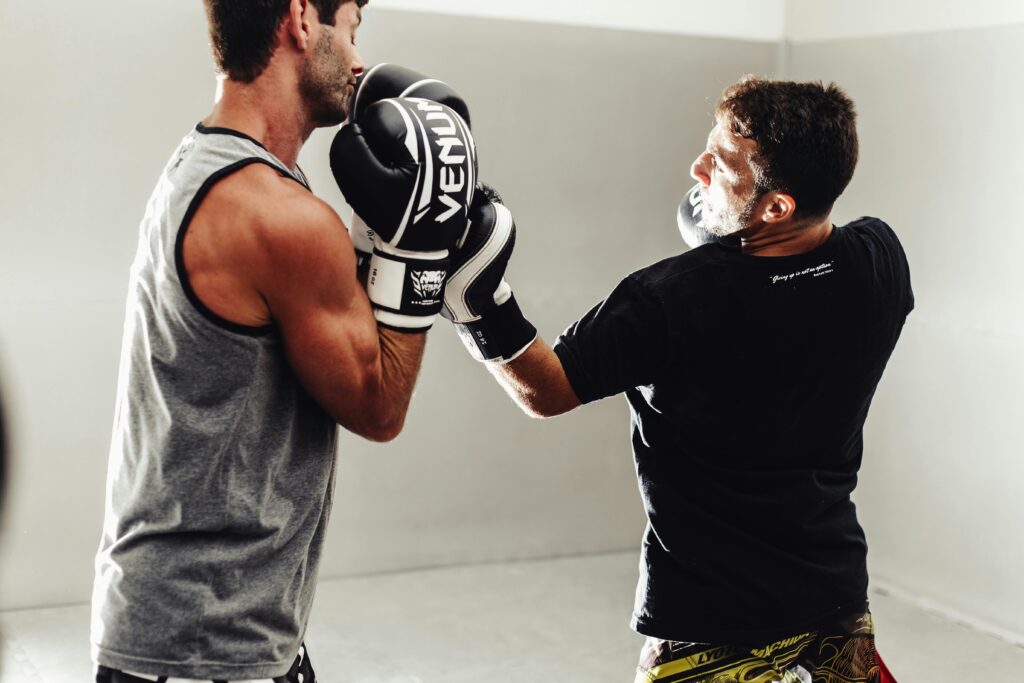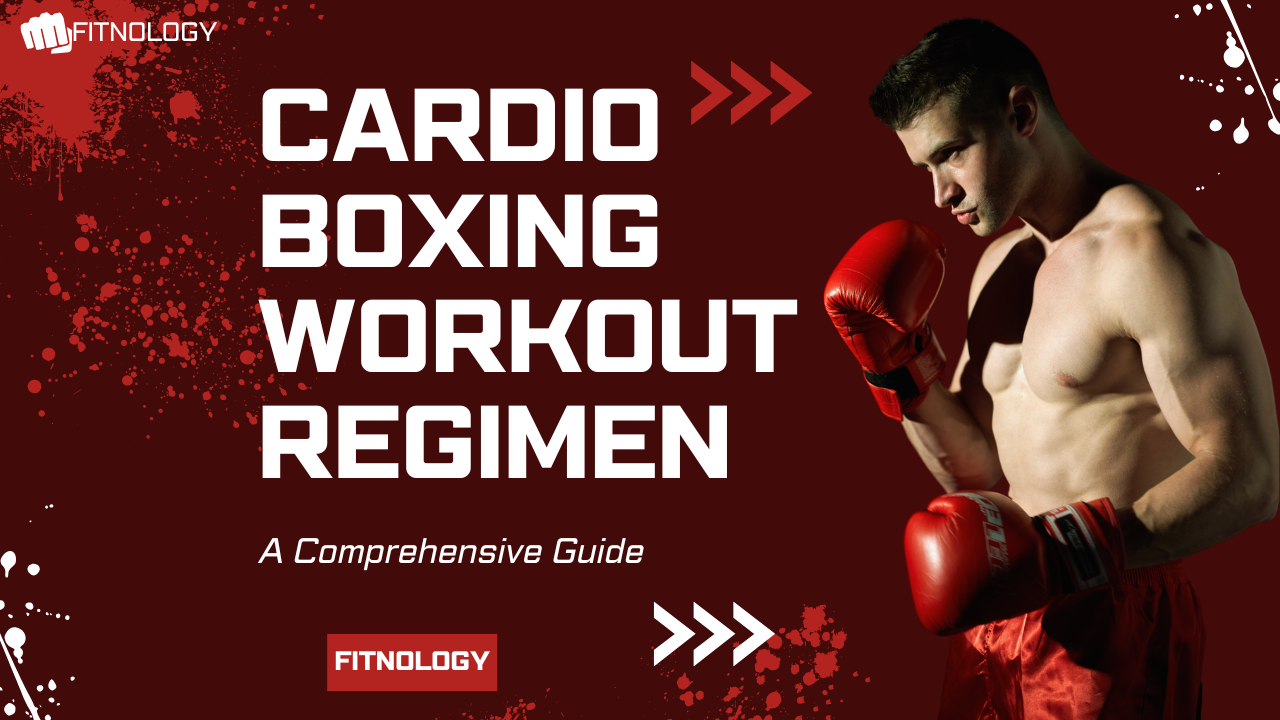Introduction
Staying fit in today’s world of fast pace is more difficult than ever. But it’s also more important. Cardio boxing is a combination of cardio exercise and boxing technique that has become a favourite among people looking for an effective workout. The full-body exercise not only helps burn calories but also improves your coordination and strength. It can even boost mental resilience. In this blog, we will find a structured cardio boxing workout regimen, following the Problem-Agitation-Solution (PAS) framework, while incorporating case studies and personal experiences to provide a realistic and engaging perspective.

The Problem: Sedentary Lifestyles and Limited Exercise Options
Sedentary habits, including prolonged screen use, minimal physical activity, and excessive sitting, dominate our daily lives. A study conducted by the World Health Organization found that insufficient physical exercise is one of the leading causes of global mortality. It contributes to millions of deaths each year. Many people abandon fitness goals prematurely because traditional exercise routines are monotonous. It is then necessary to find workouts which are engaging, effective and long-lasting.
My stamina was an issue when I first started cardio boxing. Even a single cardio boxing round was exhausting at first, but I kept coming back because of the thrill of discovering new combinations.
The Agitation: Why Traditional Workouts Don’t Always Work
It’s no secret that running on the treadmill or using weights at the gym can be uninspiring. These exercises don’t provide the motivation needed for many people to stay consistent. Conventional workouts can also be boring and not offer the stress relief or mental stimulation that people need to cope with their busy lives. Cardio boxing is a fitness game changer that combines physical intensity and mental stimulation for a complete experience.
The importance of progress is something I have learned. In order to maintain consistency, I increased intensity slowly, avoiding burnout or injury.
The Solution: Cardio Boxing Workout Regimen
By combining the benefits of cardio exercise with high-energy boxing movements, Cardio Boxing is a great solution. How to create an effective cardio-boxing program:
1. Warm-Up (5-10 Minutes)
Warming up is crucial to prepare the body for an intense workout. Begin with light jogging, jumping jacks and dynamic stretching to get your heart pumping and your muscles loosening up. Incorporate Shadowboxing–throwing punches in the air–to familiarize yourself with basic boxing movements.
2. Core Cardio Boxing (30-40 minutes)
Main workouts consist of intense rounds that mimic the feeling of watching a boxing bout. The average round lasts for three minutes and is followed by a one-minute break. Here is an example structure.
- 1st Round : Combinations of jab-cross and footwork
- 2nd Round : Uppercuts and hooks combined with squats
- 3rd Round : Mitt or punching bag work
- 4th Round : Speed Variations and Shadowboxing
- 5th Round : Burpees with high knees.
To keep your heart rate high, alternate these exercises.
3. Strength and Conditioning (10-15 minutes)
Include exercises such as push-ups and planks. The strength and endurance phase is a great complement to the cardio workout.
4. Cool-Down (5-10 Minutes)
Stretching statically will improve your flexibility and help reduce soreness. Stretch your arms, shoulders, legs and back for a faster recovery.
With time, I began to notice that this exercise improved my health and my attitude. I found that the rhythmic punches helped relieve stress and help me relax after a long day.

Benefits of Cardio Boxing
Scientific studies have shown that cardio boxing has many benefits.
- Calorie Burn: Cardio boxing is a great way to lose weight. It can help you burn 500-700 calories in an hour.
- Increased Heart Health: Constant movement and intervals of high intensity improve heart health through increased blood circulation and oxygen intake.
- Boxing improves coordination by requiring precise eye-hand coordination.
- Punching can help relieve stress by releasing pent-up tension.
- Strength and endurance: Combining cardio with strength training increases muscle strength and endurance.
- It is affordable and accessible: The minimal equipment required for cardio boxing is and it can be done at home or the gym. This makes it a great option for people of all fitness levels.
My advice to anyone just starting is to first focus on the technique. Correct form is important to prevent injuries and maximize the benefits of your workout.
Cardio Boxing: A Case Study of Transformative Results
The American Council on Exercise, which conducted the study in 2022, highlighted cardio boxing’s effectiveness. The participants engaged in 3 sessions per week over 12 weeks. The results showed an average loss of six pounds in weight, as well as a 10% increase in cardio endurance and stress reduction. Participants reported that they felt more energetic and confident, attributing this to the fun nature of the exercise.
A 35-year-old office worker shared that “Cardio Boxing has transformed my routine.” This is the first exercise I have done for over a month because it was fun and rewarding. “I’ve lost weight and feel stronger. I even sleep better.”
Tracking my progress has also been helpful. Noting the number of punches per round or how long I am able to hold a plank has allowed me to measure my progress.
Simple Tips for Beginners
- Beginners: Start with simpler sessions to gain confidence.
- Investing in the basics: Purchase hand wraps, gloves and a punching bag for your home exercises.
- To avoid injury, learn proper form: Attend classes or watch tutorials to improve your technique.
- Keep Consistent. Aim to attend at least three sessions a week for noticeable results.
- Monitor your progress: You can use fitness apps and journals to track your progress.
High-Intensity Interval Training (HIIT) Workouts
The HIIT method involves short, intense bursts followed by a brief rest period. This format is perfect for cardio boxing, which includes quick punches, body movements, and footwork that are alternated by short breaks. The structure increases calorie burning and improves endurance and cardiovascular health. People choose HIIT because of its effectiveness, particularly when they are limited in time.

Strength Training
Strength training is a method of building muscles and increasing physical strength. You know Strength exercises like weighted strikes or push-ups can be incorporated into boxing workouts to maximize their benefits. Strengthening muscles increases punch power and also reduces the chance of an injury. Fitness enthusiasts now prefer strength training and boxing to achieve a balanced routine that increases both endurance and power.
Wearable Technology
Smartwatches, fitness trackers and other devices have changed the way people keep tabs on their exercise. They provide feedback in real-time on metrics like heart rate, calories burned, and active minutes. Wearables can be used to track cardio boxing performance, helping users stay in their heart rate zone for maximum results.
Virtual Reality Fitness
VR fitness combines technology and exercise for immersive workouts. Users can engage in virtual sparring or punching drills in boxing VR programs. They can even compete against virtual opponents. The innovative method adds a fun element and makes workouts more motivating.
Online Personal Training
Online platforms have made training for personal development more accessible. Virtual boxing classes let individuals learn from professionals at home. The programs may include pre-recorded video or live sessions with customized training. These programs are ideal for those who have limited time or access to gyms.
Mental Health and Exercise
Boxing is a great way to combat stress and anxiety. A punching bag or even practising a combination of moves can be a great way to release frustration and anxiety. The focus needed during a workout can help distract negative thoughts and promote mental clarity.
Exercise Programs for Senior Adults
Boxing has many benefits for both young and older athletes. Low-impact boxing exercises are used in specialized programs to enhance balance, coordination and cardiovascular health. The workouts have been designed to help seniors stay active while decreasing the risks of ageing, such as falling or reduced mobility.
Exercise Classes for Groups
The group setting offers motivation, camaraderie and a feeling of community. Gyms are adding more and more boxing-inspired classes to their programs. In a team-oriented, high-energy environment, participants can learn punch combinations, footwork and strength exercises. This makes the workout less of a chore and more enjoyable.
Exercise Equipment for Home
Boxing gear like gloves, punching bags and resistance bands are becoming more popular due to the demand for fitness at home. Individuals can create a boxing gym at home for a minimal cost, which allows them to train whenever they want. The popularity of this trend is growing as more people are looking for alternatives to busy gyms.
Young Athletic Development
The sport of boxing has been introduced to young audiences in order to develop their athletic abilities. The focus of youth programs is on teaching discipline and improving fitness. Boxing is a great way for parents and coaches to engage their children in a healthy activity that will help them develop strength and motor skills.

Mastering the Basics of Cardio Boxing: Key Techniques for Beginners
Overview This article will be a good introduction for those who are just beginning to learn about boxing with cardio. The topic will break down the fundamental skills and methods required to be able to do their job efficiently and safely in the cardio boxing workout. Knowing the fundamentals is essential for avoiding injuries as well as forming a sturdy foundation to perform more complex moves.
Key Points to Cover:
- A Proper Stance The necessity of maintaining a well-balanced athletic, athletic stance for flexibility and stability.
- Basic Punches explaining the most important punches that are used during cardio boxing. This includes the cross, jab uppercut, and hook. For those who are new to the sport, it is important to focus on the form of hand, position, as well as speed.
- Footwork teaching simple footwork exercises that improve movements, including moving, stepping, and pivoting, as well as side-to-side shifts. These are essential for remaining balanced and agile.
- Breathing Strategies Tips for co-ordinating breathing with movements and punches for endurance through training.
- Warm-up and Cool-Down Guidelines on the proper stretching and preparation in order to avoid injuries and increase flexibility.
Aims at beginners who would like to understand the basics of cardio boxing in a well-structured, simple format that is easy to follow.
The Benefits of Cardio Boxing: How It Transforms Your Body and Mind
Introduction The purpose of this article is to present the numerous physical and mental benefits that come from incorporating boxing and cardio into your regular exercise routine. The article will provide proof and insight into how this exercise affects different aspects of well-being and health and makes it a great alternative for anyone looking for an all-encompassing fitness regimen.
Key Points to Cover:
- Physical Benefits :
- Cardiovascular Health: The benefits of cardio-boxing for the health of your heart by increasing your stamina and heart rate.
- Weight loss and fat burning: The burning of calories of cardio boxing, and the way it aids in losing fat, which makes it an excellent workout for managing weight.
- Muscle Toning is a description of the ways that punching, in conjunction with a combination of footwork and movements, can help tone muscles of the core, arms, and legs.
- Enhances Strength and endurance In time, the consistent use of cardio improves stamina and Strength, which allows you to push further during training.
- Mental Benefits :
- Stress relief The high intensity of cardio boxing’s design is ideal for breaking down the tension that has built up and helping lower stress levels.
- Better Concentration and Discipline The coordination that is required when boxing improves concentration as well as the structured nature of workouts helps to build a sense of discipline.
- Increased confidence: As Strength and techniques improve, so does self-confidence. Specifically in the sense of knowing how to defend yourself physically.
Aims at People who are looking to understand the wide positive, transformational benefits of cardio boxing both mentally and physically, as well as how it could support overall wellness.
Building a Cardio Boxing Routine: Customizing Your Workout for Maximum Result
Introduction The topic will target those who are familiar with cardio boxing and want to go further, making a workout program to suit the specific goals of their fitness. Suppose someone’s objective is weight loss, Strength, and building or improving cardio endurance. In that case, this post will guide users on the best way to design an exercise program that maximizes efficiency.
Key Points to Cover:
- Setting goals How do you define the goals you want to achieve in your fitness (weight reduction, toning muscles and endurance, and so on.) and alter a cardio boxing regimen to reach them?
- Workout Form Tips for how to divide the workout into segments: warm-up and rounds, drills (focusing specifically on punches and moves) as well as cooling down. It could also incorporate interval training and circuits.
- Intensity and Progress: how to gradually raise the intensity (e.g., increasing speed and longer intervals or incorporating footwork that is more complicated) to keep challenging the body and avoid stagnation.
- Cross-Training Suggestions for integrating different types of training, such as strength training or yoga, to enhance fitness boxing with cardio and increase the outcomes.
- Recuperation and Recovery Important to take rest days and methods to recover from excessive training and improve performance.
Aims at People who do cardio boxing and would like to design an individual plan to help them achieve their personal fitness goals, be it losing weight, building strength, or cardio fitness.
Conclusion
Cardio boxing offers more than just an intense workout. It’s also a stress-relieving activity that engages the mind and body. Anyone can benefit from cardio boxing by following a regimented routine and focusing their efforts on progress. Cardio boxing is a great way to improve your health, whether you are a fitness fanatic or want to get out of a sedentary lifestyle. Begin your journey to become stronger, healthier and happier today.
FAQs
What is Cardio Boxing?
Cardio boxing combines cardio and boxing movements like footwork, punches, etc., for an intense workout.
Does cardio boxing help you lose weight?
Cardio boxing is a great way to lose weight. It burns between 500 and 700 calories an hour, boosts your metabolism, and helps you achieve a healthy body weight.
What do I need to get started?
You can practice Shadowboxing without equipment to learn the basics.
Can I do cardio boxing at home?
It’s possible to practice at home, with minimal equipment. Gloves or punching bags are optional.
Can beginners do cardio boxing?
Absolutely. You can begin with the basics and then progress to more advanced movements as your skills and stamina increase.
What are some of the main benefits of cardio boxing training?
Exercise improves your cardiovascular health and burns calories. It also builds muscle, increases coordination, and decreases stress.
What is the frequency of cardio boxing?
Aim for three to four sessions per week of 30-60 minutes each.
Can older adults do cardio boxing?
This is an excellent way to help older adults improve their coordination, balance and heart health.
Does cardio boxing help relieve stress?
The act of punching and the concentration required to do so during sessions is excellent at reducing stress.
Is prior experience in boxing required?
Cardio boxing can be adapted to all levels of fitness. Techniques are taught in classes or tutorials.

